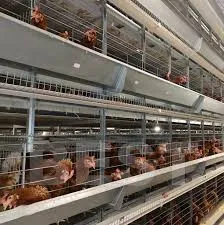Efficient Automated Pig Feeding Solutions for Modern Farming Practices
Nov . 18, 2024 08:13 Back to list
Efficient Automated Pig Feeding Solutions for Modern Farming Practices
Automatic Pig Feeding System Revolutionizing Swine Nutrition
In the ever-evolving realm of agricultural technology, the automatic pig feeding system stands out as a revolutionary development aimed at enhancing efficiency, animal welfare, and overall productivity in pig farming. This innovative system is designed to automate the feeding process, ensuring that pigs receive the right amount of nutrients at the right time, which significantly impacts their growth and health.
One of the primary advantages of an automatic pig feeding system is its ability to optimize feed utilization. Traditional feeding methods, which often rely on manual labor, can lead to inconsistencies in feed delivery. Overfeeding or underfeeding not only results in wasted resources but can also negatively impact the pigs' growth rates and overall health. By employing an automatic system, farmers can ensure precise portion control based on the specific needs of each pig, thereby optimizing feed conversion ratios and improving overall animal performance.
Furthermore, these systems are equipped with advanced technology that allows farmers to monitor and adjust feeding patterns remotely. Sensors and connected devices collect data on each pig’s growth, feed intake, and health status, enabling farmers to make informed decisions. This data-driven approach ensures that dietary requirements are met based on age, weight, and health conditions, promoting a healthier and more productive herd.
The automation of feeding processes also mitigates some of the challenges associated with labor shortages in the agricultural sector. With fewer workers available for manual feeding, farmers can leverage automatic systems to maintain operational efficiency. This not only allows for better management of time and resources but also reduces labor costs, making pig farming more economically viable.
automatic pig feeding system

Animal welfare is another critical area where automatic pig feeding systems make a significant impact. By providing pigs with a steady supply of feed, these systems reduce competition among animals, leading to less stress and aggression. Pigs are social animals, and a calmer environment contributes to their overall well-being. Healthier pigs are not only more productive but also require fewer veterinary interventions, further enhancing the farm’s profitability.
Moreover, these feeding systems often incorporate advanced features such as adjustable feeding schedules and the ability to offer different feed types based on specific nutritional needs. For instance, sows in different stages of gestation may require varying diets to ensure optimal reproductive health. Automatic feeders can be programmed to cater to these needs, ensuring that each animal receives tailored nutrition.
Sustainability also plays a pivotal role in the adoption of automatic pig feeding systems. By reducing feed wastage and ensuring that pigs receive the necessary nutrients without excess, farmers are contributing to more sustainable agricultural practices. Furthermore, many of these systems are designed to utilize renewable energy sources, such as solar power, reducing the carbon footprint of pig farming operations.
In conclusion, the automatic pig feeding system represents a significant leap forward in the swine industry. By integrating technology into traditional farming practices, farmers can enhance efficiency, optimize nutrition, and improve animal welfare. As the demand for pork continues to rise globally, these systems will play a critical role in meeting consumer needs while promoting sustainable farming practices. The future of pig farming lies in modernization and automation, and the automatic pig feeding system is at the forefront of this transformation, paving the way for a more productive and responsible agricultural sector.
-
Hot Sale 24 & 18 Door Rabbit Cages - Premium Breeding Solutions
NewsJul.25,2025
-
Automatic Feeding Line System Pan Feeder Nipple Drinker - Anping County Yize Metal Products Co., Ltd.
NewsJul.21,2025
-
Automatic Feeding Line System Pan Feeder Nipple Drinker - Anping County Yize Metal Products Co., Ltd.
NewsJul.21,2025
-
Automatic Feeding Line System - Anping Yize | Precision & Nipple
NewsJul.21,2025
-
Automatic Feeding Line System - Anping Yize | Precision & Nipple
NewsJul.21,2025
-
Automatic Feeding Line System-Anping County Yize Metal Products Co., Ltd.|Efficient Feed Distribution&Customized Animal Farming Solutions
NewsJul.21,2025






